Abstract
The mode of recognition and hence the frequency of apocrine differentiation in breast carcinomas, assessed on purely morphologic grounds, remains uncertain. One hundred consecutive cases of breast carcinoma were studied in order to establish the incidence of this type of tumor. With the use of an immunocytochemical method for the detection of GCDFP-15, a protein present in apocrine epithelium and in the fluid of tension cyst of the breast, the presence of apocrine differentiation was confirmed in 4 cases initially diagnosed as apocrine carcinomas on histologic grounds. Eight additional cases contained immunoreactive cells: 1 contained 10% of positive cells scattered throughout the tumor, and the other 7 cases were only focally positive. In 4 of these latter cases positive staining was confined to the in situ component. The ultrastructural findings in 2 cases of apocrine carcinoma are discussed in order to link the morphologic features for recognizing this tumor type and the presence of the antigenic apocrine marker.
Full text
PDF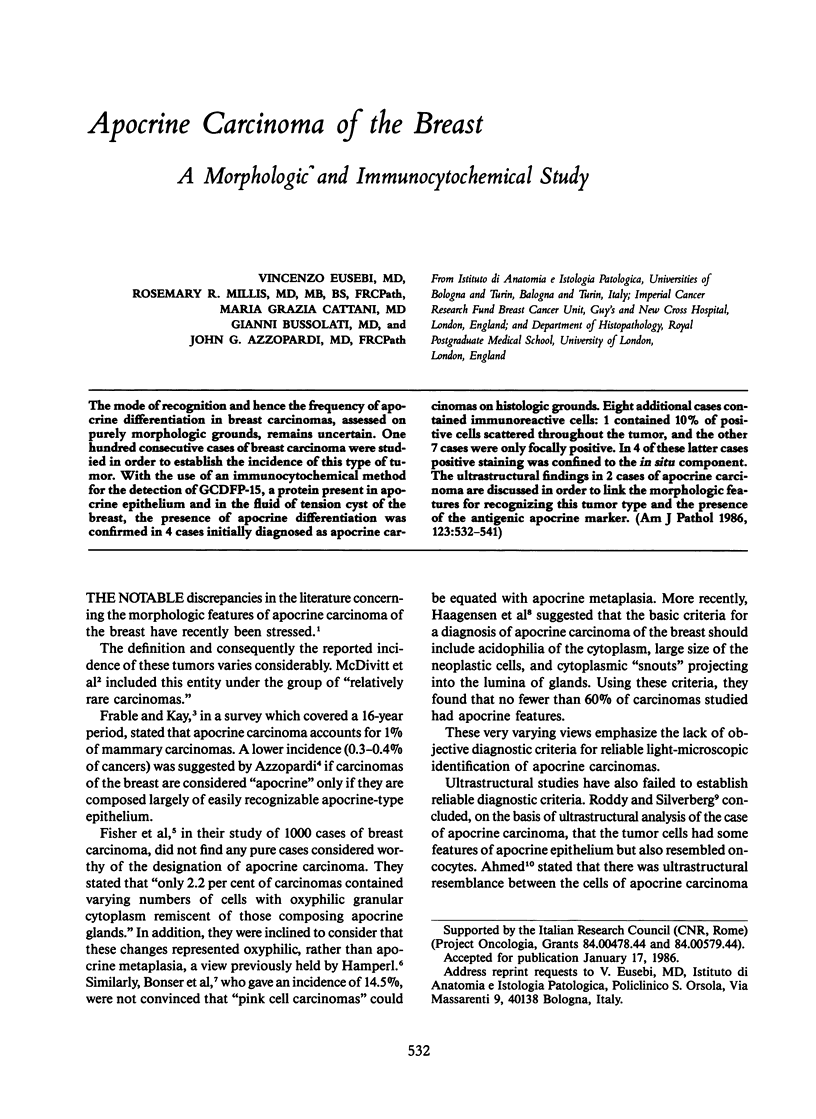

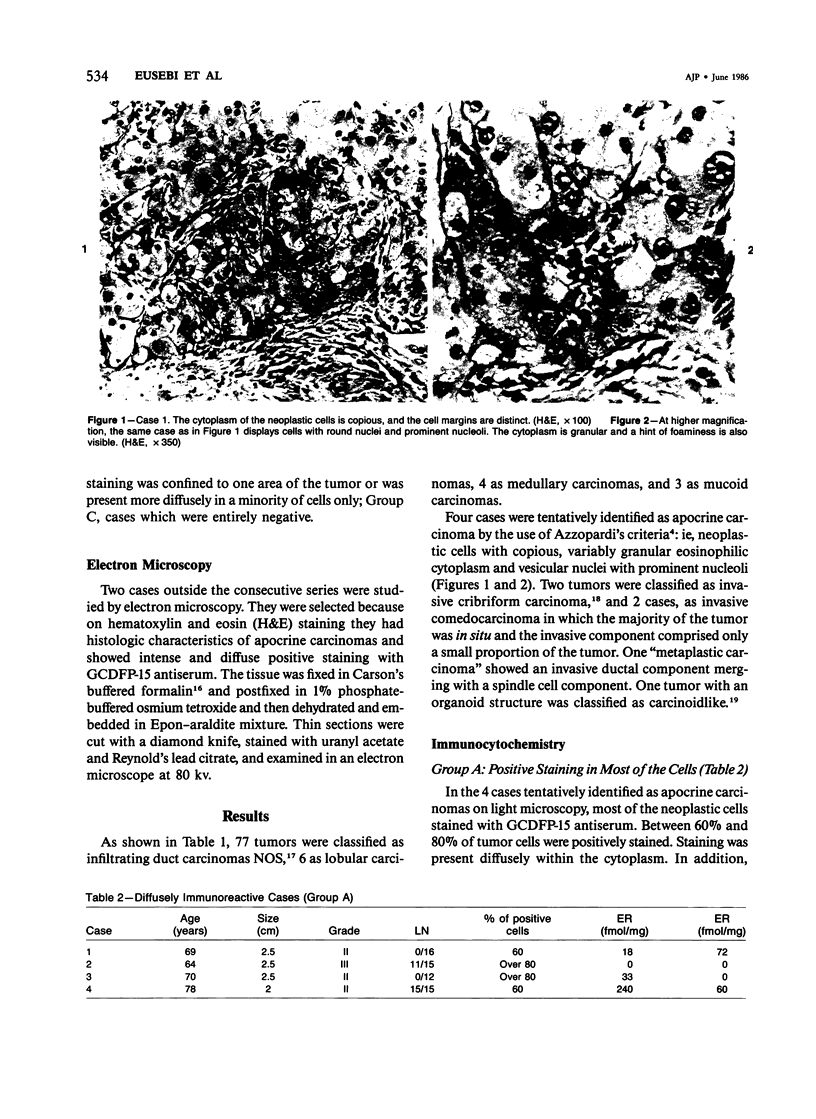

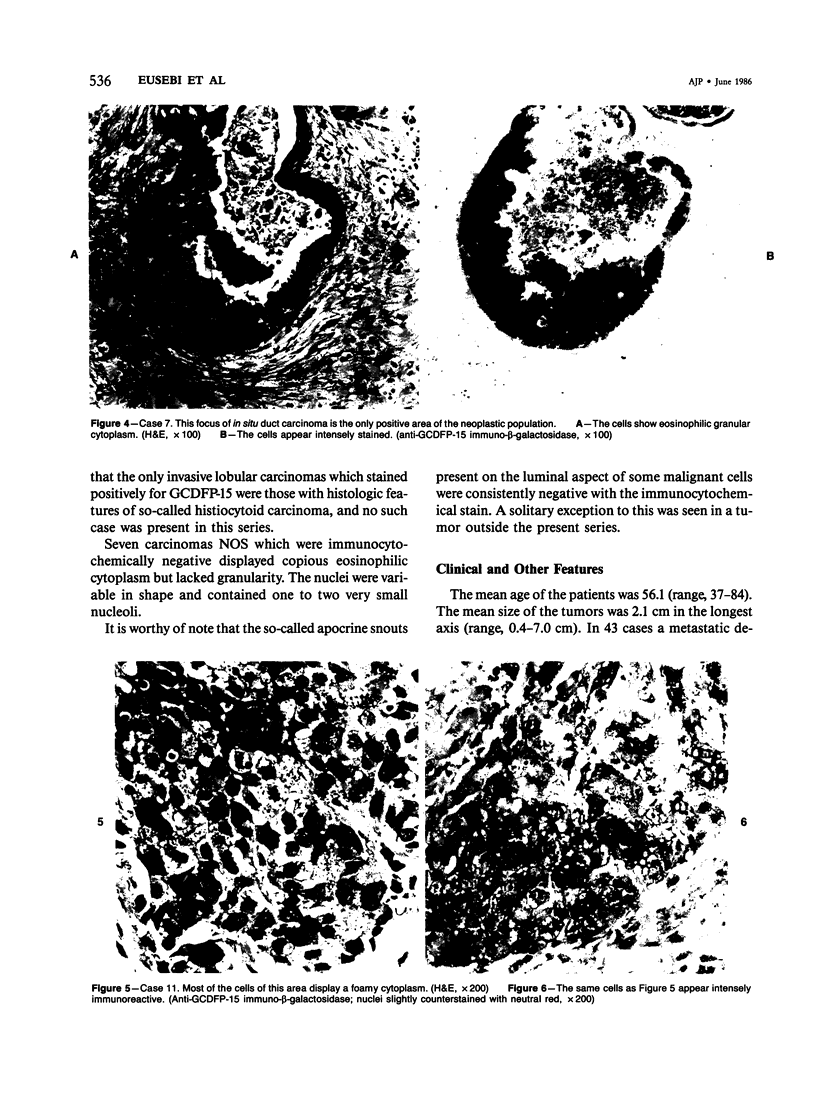

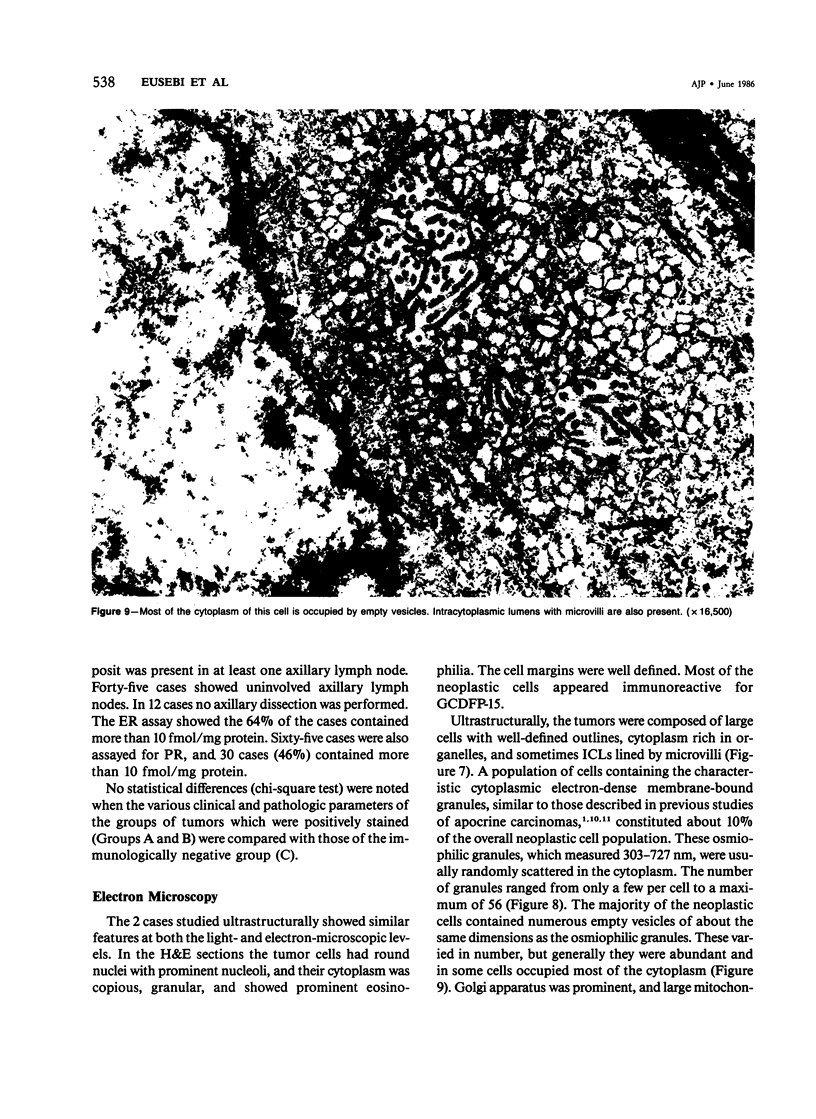

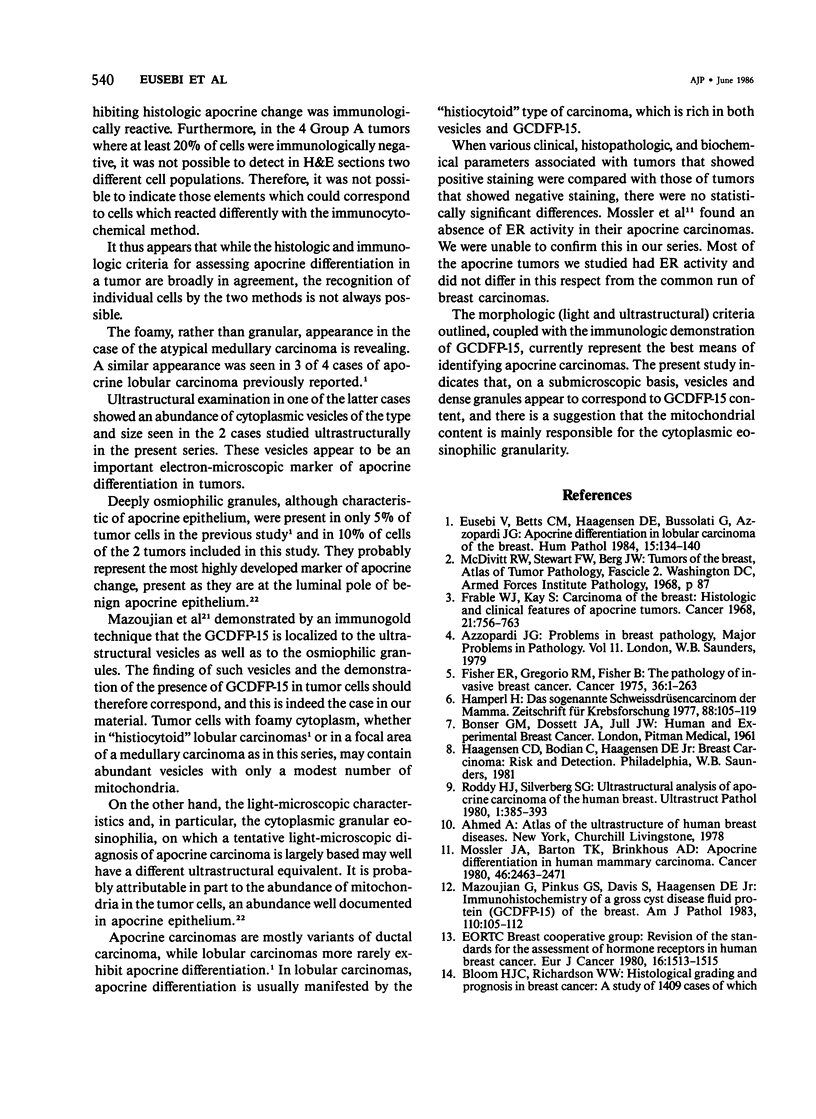
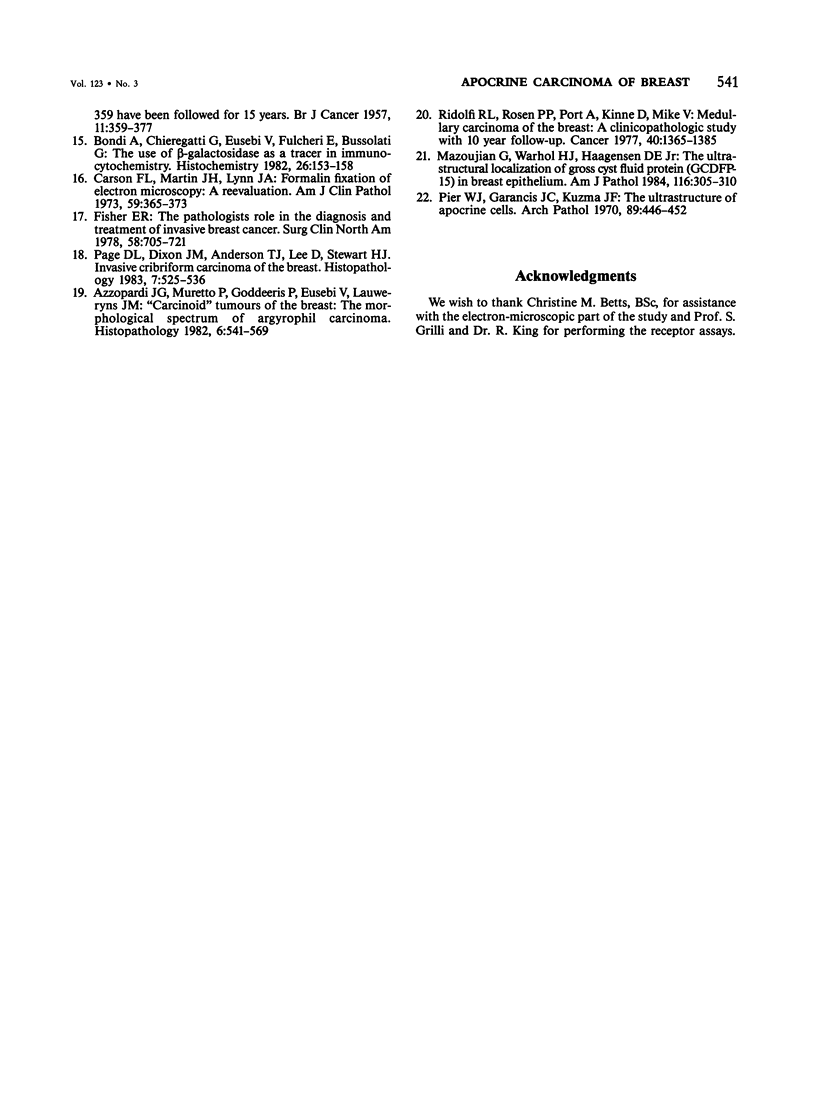
Images in this article
Selected References
These references are in PubMed. This may not be the complete list of references from this article.
- Azzopardi J. G., Muretto P., Goddeeris P., Eusebi V., Lauweryns J. M. 'Carcinoid' tumours of the breast: the morphological spectrum of argyrophil carcinomas. Histopathology. 1982 Sep;6(5):549–569. doi: 10.1111/j.1365-2559.1982.tb02750.x. [DOI] [PubMed] [Google Scholar]
- BLOOM H. J., RICHARDSON W. W. Histological grading and prognosis in breast cancer; a study of 1409 cases of which 359 have been followed for 15 years. Br J Cancer. 1957 Sep;11(3):359–377. doi: 10.1038/bjc.1957.43. [DOI] [PMC free article] [PubMed] [Google Scholar]
- Bondi A., Chieregatti G., Eusebi V., Fulcheri E., Bussolati G. The use of beta-galactosidase as a tracer in immunocytochemistry. Histochemistry. 1982;76(2):153–158. doi: 10.1007/BF00501918. [DOI] [PubMed] [Google Scholar]
- Carson F. L., Martin J. H., Lynn J. A. Formalin fixation for electron microscopy: a re-evaluation. Am J Clin Pathol. 1973 Mar;59(3):365–373. doi: 10.1093/ajcp/59.3.365. [DOI] [PubMed] [Google Scholar]
- Eusebi V., Betts C., Haagensen D. E., Jr, Gugliotta P., Bussolati G., Azzopardi J. G. Apocrine differentiation in lobular carcinoma of the breast: a morphologic, immunologic, and ultrastructural study. Hum Pathol. 1984 Feb;15(2):134–140. doi: 10.1016/s0046-8177(84)80053-2. [DOI] [PubMed] [Google Scholar]
- Fisher E. R., Gregorio R. M., Fisher B., Redmond C., Vellios F., Sommers S. C. The pathology of invasive breast cancer. A syllabus derived from findings of the National Surgical Adjuvant Breast Project (protocol no. 4). Cancer. 1975 Jul;36(1):1–85. doi: 10.1002/1097-0142(197507)36:1<1::aid-cncr2820360102>3.0.co;2-4. [DOI] [PubMed] [Google Scholar]
- Fisher E. R. The pathologist's role in the diagnosis and treatment of invasive breast cancer. Surg Clin North Am. 1978 Aug;58(4):705–721. doi: 10.1016/s0039-6109(16)41583-5. [DOI] [PubMed] [Google Scholar]
- Frable W. J., Kay S. Carcinoma of the breast. Histologic and clinical features of apocrine tumors. Cancer. 1968 Apr;21(4):756–763. doi: 10.1002/1097-0142(196804)21:4<756::aid-cncr2820210428>3.0.co;2-y. [DOI] [PubMed] [Google Scholar]
- Hamperl H. Das sogenannte Schweissdrüsencarcinom der Manna. Eine Ubersicht. Z Krebsforsch Klin Onkol Cancer Res Clin Oncol. 1977 Jan 21;88(2):105–119. doi: 10.1007/BF00284119. [DOI] [PubMed] [Google Scholar]
- Mazoujian G., Pinkus G. S., Davis S., Haagensen D. E., Jr Immunohistochemistry of a gross cystic disease fluid protein (GCDFP-15) of the breast. A marker of apocrine epithelium and breast carcinomas with apocrine features. Am J Pathol. 1983 Feb;110(2):105–112. [PMC free article] [PubMed] [Google Scholar]
- Mazoujian G., Warhol M. J., Haagensen D. E., Jr The ultrastructural localization of gross cystic disease fluid protein (GCDFP-15) in breast epithelium. Am J Pathol. 1984 Aug;116(2):305–310. [PMC free article] [PubMed] [Google Scholar]
- Mossler J. A., Barton T. K., Brinkhous A. D., McCarty K. S., Moylan J. A., McCarty K. S., Jr Apocrine differentiation in human mammary carcinoma. Cancer. 1980 Dec 1;46(11):2463–2471. doi: 10.1002/1097-0142(19801201)46:11<2463::aid-cncr2820461127>3.0.co;2-#. [DOI] [PubMed] [Google Scholar]
- Page D. L., Dixon J. M., Anderson T. J., Lee D., Stewart H. J. Invasive cribriform carcinoma of the breast. Histopathology. 1983 Jul;7(4):525–536. doi: 10.1111/j.1365-2559.1983.tb02265.x. [DOI] [PubMed] [Google Scholar]
- Pier W. J., Jr, Garancis J. C., Kuzma J. F. The ultrastructure of apocrine cells in intracystic papilloma and fibrocystic disease of the breast. Arch Pathol. 1970 May;89(5):446–452. [PubMed] [Google Scholar]
- Ridolfi R. L., Rosen P. P., Port A., Kinne D., Miké V. Medullary carcinoma of the breast: a clinicopathologic study with 10 year follow-up. Cancer. 1977 Oct;40(4):1365–1385. doi: 10.1002/1097-0142(197710)40:4<1365::aid-cncr2820400402>3.0.co;2-n. [DOI] [PubMed] [Google Scholar]
- Roddy H. J., Silverberg S. G. Ultrastructural analysis of apocrine carcinoma of the human breast. Ultrastruct Pathol. 1980 Jul-Sep;1(3):385–393. doi: 10.3109/01913128009141441. [DOI] [PubMed] [Google Scholar]











